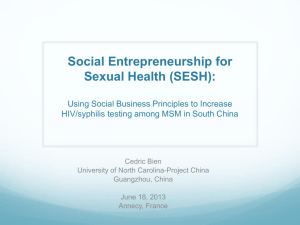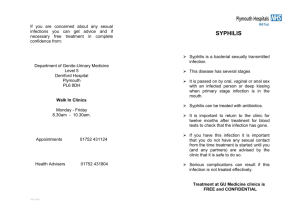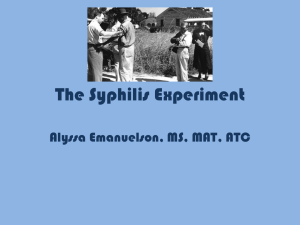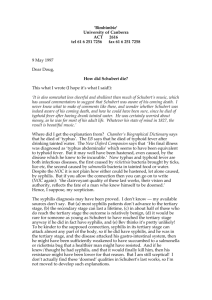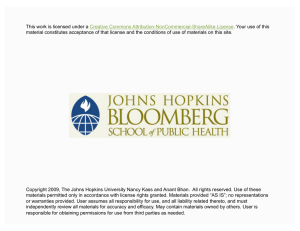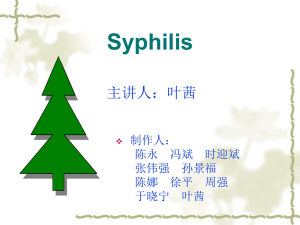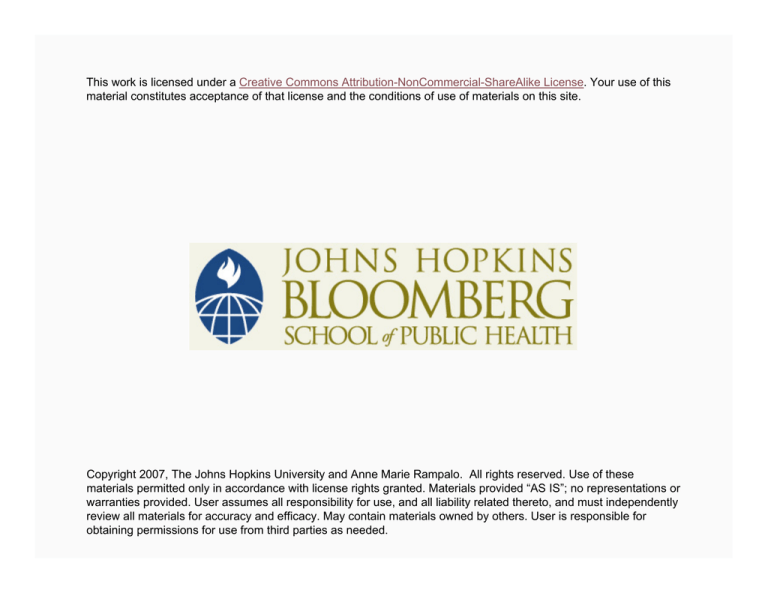
This work is licensed under a Creative Commons Attribution-NonCommercial-ShareAlike License. Your use of this
material constitutes acceptance of that license and the conditions of use of materials on this site.
Copyright 2007, The Johns Hopkins University and Anne Marie Rampalo. All rights reserved. Use of these
materials permitted only in accordance with license rights granted. Materials provided “AS IS”; no representations or
warranties provided. User assumes all responsibility for use, and all liability related thereto, and must independently
review all materials for accuracy and efficacy. May contain materials owned by others. User is responsible for
obtaining permissions for use from third parties as needed.
Breaking the Transmission Chain:
New Approaches for Syphilis Control and
the Role of Sexual and Social Networks
Anne Marie Rompalo, MD, ScM
Johns Hopkins University
Section A
Problem Definition
Syphilis: The Public Health Challenge
Good news
Caused by the bacterium
Treponema pallidum
− Curable with cheap antibiotics
Incubation period is 9 to 90 days
− Should be able to find exposed
sex contacts and treat them
before they are infectious
Bad news
Presents with protean
manifestations and may be
challenging to recognize and
appropriately diagnose
Cannot culture organism in vitro
− Diagnosis relies on imperfect
serologic tests
Stigma attached to disease,
diagnosis, and treatment
4
Disease Intervention Strategies
Diagnosis and treatment
Screening
Selective
Mass
Prophylaxis
Immunologic
Chemotherapeutic
Personal
Epidemiologic investigation
Contact tracing
Partner notification and referral
Outbreak investigation
Behavioral modification
Provider education
Public education (mass media)
Patient (individual) education
Targeted education (e.g., schools)
5
Thomas Parran’s Shadow on the Land
Thomas Parran, MD
Surgeon General of U.S. Public Health Service
Shadow on the Land, 1937
Introduced contact tracing on a wide scale as a means of finding
cases and interrupting patterns of infection and reinfection
Genesis of current partner notification
If applied rigorously, it has been effective in reducing outbreaks and
containing syphilis
Parran conceived syphilis as being spread via heterosexual contact
with identifiable sex partners in identifiable venues
6
U.S. Primary and Secondary Syphilis Rates, 1941–2003
Parran
model
Sexual
revolution
Drug use
AIDS
Syphilis
elimination
efforts
7
Current Partner Notification
Disease intervention specialist (DIS)-assisted partner notification
− Identify partners of a person diagnosed with syphilis (index case
or original patient)
X Notify partners of their exposure
X Convince them to seek evaluation and treatment
− Goal: treat infected persons and prophylactically treat those
who may be incubating the infection in order to reduce the
prevalence and incidence of syphilis
8
DIS Activities
Interview the index case for their sex partners’ identifying and
locating information
Find and notify those partners
Try to convince partners to seek evaluation and treatment (can
draw blood in the field if phlebotomy trained)
Many also contact other persons mentioned by the index case and
deemed “at risk” by the DIS
− “Best friend” who went to a club to pick up a sex partner
9
How Are These Activities Evaluated for Effectiveness?
Each stage in this process can be measured relative to the index
case or to the number of partners claimed by the index case
− E.g., in Louisiana between 1993 and 1996, 78% of named
partners and other contacts were located (1.8 per index case),
0.76 per index case was prophylactically treated, and 0.31 per
index case was a previously undiagnosed case of syphilis
− A recent review of 18 U.S. estimates found median of 0.22
newly diagnosed case per index patient and 0.08 newly
diagnosed case per named partner
10
The Current Syphilis Epidemic
2003 Provisional Summary Partner Management Data for MSM With Primary & Secondary Syphilis
Atlanta
Chicago
Fort
Lauderdale
Houston
LA
Miami
New
York
San
Francisco
Total known MSM diagnosed
254
170
141
132
283
113
105
319
MSM as proportion of all cases diagnosed
36
63.6
78.8
65.7
72.6
58.2
86.1
95.5
64.2
64.1
75.2
87.1
84.8
50.4
63.8
61.1
Sex partners claimed
771
1022
1086
825
2585
432
317
3216
% Reporting anonymous partners
44.9
63
n/a
65
68
n/a
n/a
89
% Reporting no contacts of insufficient locating info
46.5
42.6
43.1
38.9
12
40.6
61
9.1
Partners contacted
371
249
88
129
254
64
41
383
Partners tested
n/a
115
80
99
254
59
30
272
Partners treated
121
96
35
67
n/a
36
29
237
Partners previously treated
34
46
31
11
n/a
19
9
47
Infected partners
24
14
10
12
n/a
14
5
37
Partners per index case
3.04
6.01
7.7
6.25
9.13
3.82
3.02
10.08
Contacts made per index case
1.46
1.46
0.62
0.98
0.9
0.57
0.39
1.2
Contacts as a proportion of all partners claimed
0.48
0.24
0.08
0.16
0.1
0.15
0.13
0.12
Cases found per index case (including Disposition E)
0.23
0.35
0.29
0.17
n/a
0.31
0.13
0.26
Cases found per index case (excluding Disposition E)
0.09
0.08
0.07
0.09
n/a
0.12
0.05
0.12
DIAGNOSIS STATISTICS
Proportion of MSM diagnosed outside HD settings
INTERVIEW STATISTICS
NOTIFICATION STATISTICS
NOTIFICATION EFFECTIVENESS STATISTICS
11
So What’s Happening?
Current epidemic involves MSM
Over half are HIV co-infected
Many anonymous sexual contacts met through
− Chat rooms
− Web sites
− Bath houses
− Bars
− Parks
Use of party drugs (methamphetamines and Viagra)
Oral sex believed to be safe
− Chicago outbreak: oral sex was only sex exposure for 23% of
primary syphilis and 20% of secondary syphilis cases
— (2004). MMWR, 53, 966–968.
“Barebacking” (anal intercourse without condoms)
12
Primary and Secondary Syphilis Rates by Gender
STD Surveillance 2003, CDC
13
Syphilis Rates by Race and Ethnicity
Primary and secondary syphilis rates by race and ethnicity
STD Surveillance 2003, CDC
14
Syphilis Rates by Age and Sex for 1982
1982
Rate Per 100,000 Population
70
64.2
58.9
60
Men
50
45.5
40
32.5
26.2
30
21.6
20
19
23.1
22.1
16.8
9.8
10
Women
11.5
6.4
0.5 1.5
4.1
2.2 3.9 0.5 0.5
0
7.2
0
10-14
15-19
20-24
25-29
30-34
35-39
40-44
45-54
55-64
65+
Total
Age
15
Syphilis Rates by Age and Sex for 1993
1993
Rate Per 100,000 Population
70
61.4
56.3
60
Men
56.2
51.6
47.4
50
38.5
40
37.5
35.3
30
24.6
20.5
23.4
19.6
17.8
20
17.2
9.2
10
0.5
Women
9
5
3.1
1.2 2.6 0.2
0
10-14
15-19
20-24
25-29
30-34
35-39
40-44
45-54
55-64
65+
Total
Age
16
Syphilis Rates by Age and Sex for 2003
2003
Rate Per 100,000 Population
70
Men
60
Women
50
40
30
20
10
6
0 0.1 1.4 1.7
11.8
9.7
7.9
8.9
2.4
1.9
1.6
1.6
1.2
20-24
25-29
30-34
35-39
40-44
4.4
0.5 1.5 0.1 0.2 0
4.2
0.8
0
10-14
15-19
45-54
55-64
65+
Total
Age
17
Syphilis Rates in Seven U.S. Cities, 1981–2003
Syphilis rates
in seven U.S.
cities, 1981–
2003
Solid line =
men
Dashed line =
women
STD Surveillance 2003, CDC
18
Primary, Secondary Syphilis Rates by Sex, 1981–2004
STD Surveillance 2004, CDC
19
Current Problems with the Parran Model
Many MSM are in regular private care
− 50% of MSM cases are diagnosed outside the health department
setting
− This may delay reporting since clinicians do not always report
cases before laboratories
X Case reports are not diminished in scope, but in timing
− Many physicians distrust the health department and dislike the
interference
− May provide greater logistical difficulties for partner elicitation
interviews
X Reduced situational normative social influence and
resulting conformity
− Many MSM are employed and difficult to reach and interview
20
Sex Partner Anonymity and Identifiability
Is anonymity genuine?
Pseudoanonymity—index gives chat room or Web site where partner
was met
− San Francisco, Houston, and L.A. have used Internet-based
partner notification efforts
X Instant messaging by index to make first contact is more
effective (San Francisco data)
MSM want to “handle this myself”
− MSM patients are not always competent to perform the
notification
− Notification will not necessarily lead to treatment
21
Section B
New Models for Breaking the Transmission Chain—
Fragmenting the Network
Overview of Sexual Networks
Networks matter because of
structure
− The architecture of the
networks and how such
conformation can
modulate risk of STD
A
B
Klovdahl AS. Social network research and human subjects
protection: Towards more effective infectious disease
control. Social Networks. Volume 27, Issue 2, May 2005,
Pages 119-137. Copyright © 2005 Elsevier B.V. All rights
reserved.
Figure 1
− Each network has eight persons connected by nine relationships
− Two persons each have three partners, and the other six each
have two partners
− Transmission will be less efficient in network A, and prevention
will be more difficult in network B
− In A, in just two steps from the index person, half the network
can be infected and half spared
− In B, two steps can result in everyone being infected except for
the person on the extreme right
23
Sexual Networks
Consist of persons who are sexually connected directly or indirectly
to one another
Key features for sustaining STD/HIV transmission
− Sufficient number of persons
− Moderate to high density of connections
− Centrality of infected persons
− Pattern of partner selection—mixing between high- and low-risk
persons
24
Sexual Mixing Patterns
Mutually monogamous
− Figure A: serial monogamy; person accumulates sexual partners
one at a time
Concurrency
− Figure B: person moves back and forth among different partners
WHO IS AT GREATER RISK?
25
Networks
With MSM, numbers of partners are important as well as patterns of
connectivity
An appreciable minority of MSM report high numbers, and data from
Great Britain indicate that these men are also those most likely to
engage in unprotected sex
These represent the “core group”
They contribute a disproportionate share of HIV/STDs and can fuel
sustained transmission even when they make up only a minority of
the population
26
Core Groups
Men can enter and exit the core group at different times of their
lives
High-risk behavior appears to be correlated with synchronous
epidemics (syndemics)
− Substance abuse
− Histories of childhood sexual abuse
− Clinical depression
− Partner violence
The more complex the mix, the higher the level of sexual risk
27
Using Network Tools—The Endemic Setting
Comparative syphilis rates, 1997
Rate per
100,000
Healthy 2000 objective
State of Georgia
4
34
Fulton County
109
Zip codes 30310, 30312, 30314, 30315, 30318
251
Zip code 30318
260
28
Syphilis: High-Morbidity Zip Codes in Fulton County
29
Target Population
Men and women who live in zip code 30318 who are related to a
case of syphilis by sex, drugs, or socially
Behaviors that put this population at risk are inconsistent use of
barrier methods, multiple sex partners, sex for drugs or money, drug
use and abuse
30
Intervention Strategies
Create a street team of two project assistants
Plan for 80% of time in the field
Develop an ethnographic base: be known in the community
Interview persons with syphilis
Interview selected non-infected partners (more at first)
Elicit all contacts (sex partners, drug partners, friends)
31
Intervention Strategies
Base field decisions on known network connections and
ethnographic observations
Field blood testing
Maintain data base of all contacts, suspects, associates, and
encounters
Use of pagers and cellular phones
Use very long interview periods for everyone
Do not close a case
32
Data Sources
Standard CDC interview form (73.54)
Standard CDC field record (29.36)
Standard cluster interview form
Case management form
Weekly, monthly, and quarterly reports
Fulton County surveillance reports
Information from clinic staff
33
Data Tools
Epi Info (Mini-STD/MIS)
UCINET KRACKPLOT
Pajek
34
Changing Pattern of Case-Finding Effectiveness
March–October 1998
Group size
Syphilis cases
Network
contribution (%)
43
4
25
96
10
30
194
17
24
262
25
24
386
48
13
35
Observations
Drug relationships parallel disease transmission
Non-infected people and gatekeepers are just as valuable to the
intervention process as the infected people
Marginal contacts can be found when workers are known in the
community
Develop a relationship with the community, fostering a nonthreatening presence
Team interaction/communication is enhanced
Workers become a community resource
Knowledge of the community is enhanced
Contact index may not be an adequate measure of productivity
36
Tools for Evaluation
Observation of field activities
Analysis of data collection methods
Analysis of network diagrams
Analysis of quantitative data
Analysis of qualitative data
37
Back to Reality and the Current Epidemic
How do we fragment the network?
38
Intervene in Gay Male Venues
Bathhouses and sex clubs
− Tie together geographically isolated networks
− Public health workers have episodically used these venues to
educate and test persons at risk
X However, the number of blood tests collected are
remarkably low
X Persons likeliest to harbor the infection may be the least
likely to seek testing
39
The Internet
Two fragmentation strategies
− Help men make informed choices about their partners and thus
become better “shoppers”
X Like “e-harmony”—get more information about sexual
history, risk-taking preferences, and HIV/STD status
− Discouragement of contact between core-group, high-risk
members (both infected and uninfected) and low-risk men
40
The Internet
Use online advertising: outreach; partner notification; and
interactive, targeted interventions
Give information to become “better shoppers” to fragment sexual
networks by pulling low-risk men away from high-risk men and to
facilitate partner notification services
Dutch site has created a computerized algorithm that allowed
patrons to enter information describing themselves and their
preferences and provided them with tailored feedback
− Offered advice to an “out” gay man seeking sex with a new
partner regarding condom use
San Francisco created a Web site designed to attract men who only
seek safe sex
Another new Web site also serves to promote seroconcordant
relationships
41

